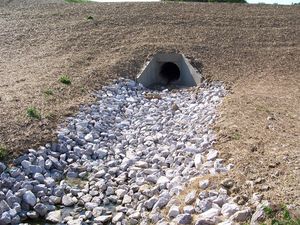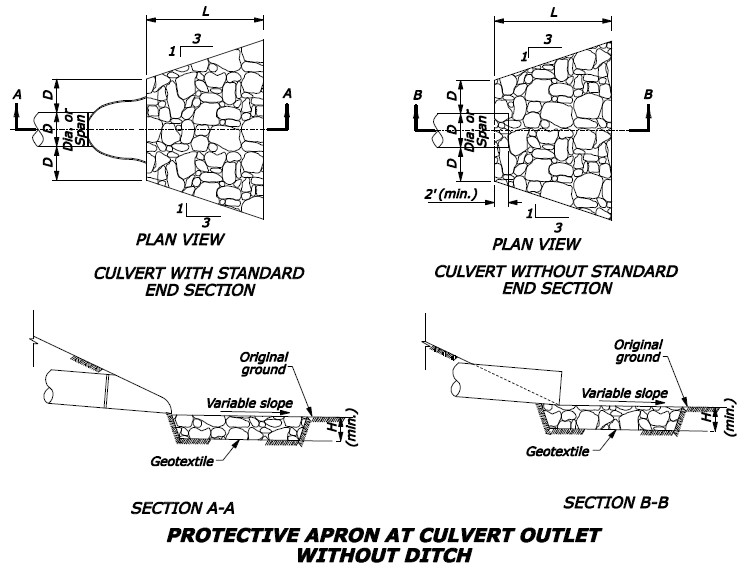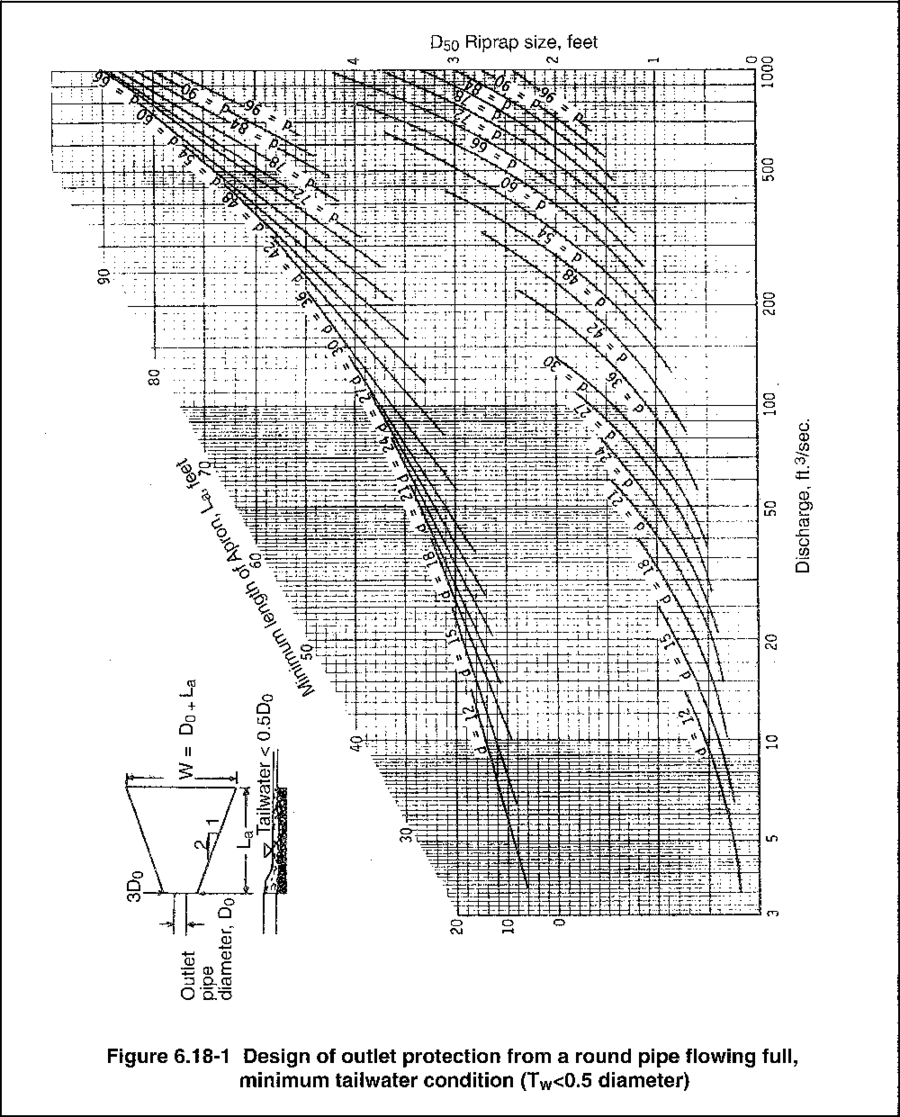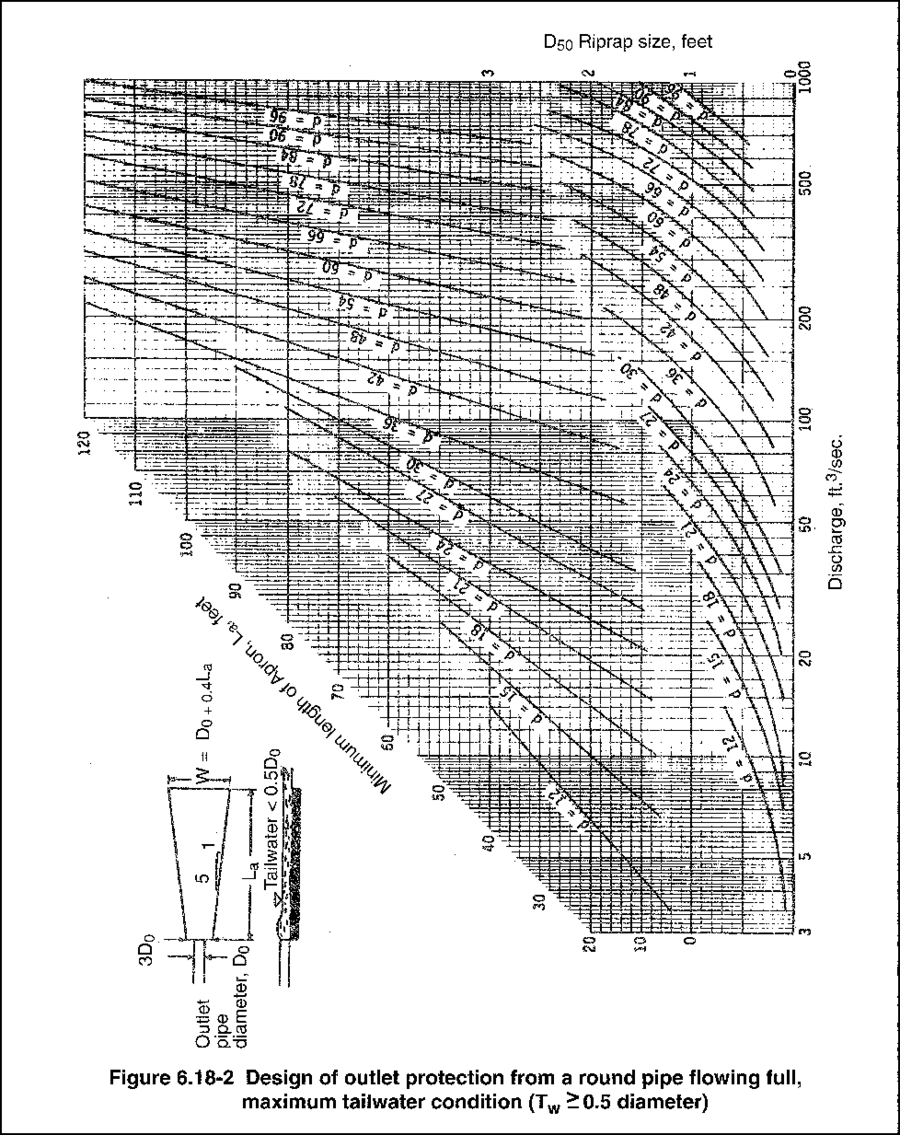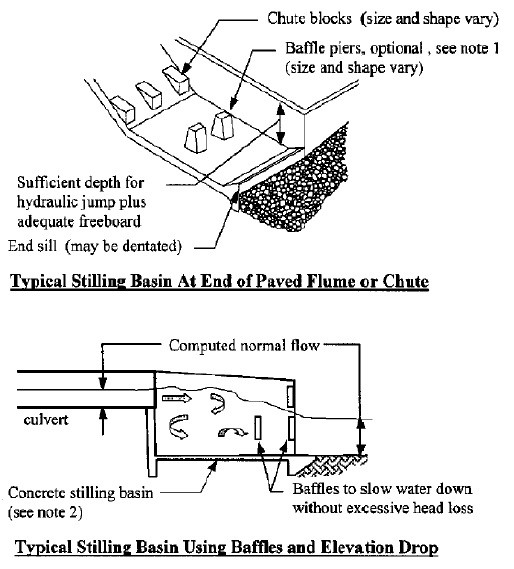
Difference between revisions of "Sediment control practices - Outlet energy dissipation"
| Line 78: | Line 78: | ||
[[File:Example riprap stilling basin plunge pool installation.jpg|right|thumb|300 px|alt=This picture shows an example riprap stilling basin plunge pool installation|<font size=3>Example riprap stilling basin plunge pool installation</font size>]] | [[File:Example riprap stilling basin plunge pool installation.jpg|right|thumb|300 px|alt=This picture shows an example riprap stilling basin plunge pool installation|<font size=3>Example riprap stilling basin plunge pool installation</font size>]] | ||
| + | |||
| + | |||
| + | [[File:Typical stilling basin designs.jpg |right|thumb|600 px|alt=This schematic shows typical stilling basin designs|<font size=3>Typical stilling basin designs</font size>]] | ||
Revision as of 20:09, 18 October 2016
This page is under development. We anticipate populating it in autumn, 2016.
Contents
Outlet Energy Dissipation (Scour Protection)
Definition
Permanent or temporary energy dissipators prevent erosion, turbulence, and turbidity where stormwater pipes or ditches discharge to unprotected areas, such as channel banks, slopes, or upslope outfall locations. Their main purpose is to reduce the speed of concentrated flows to prevent scour at conveyance outlets. This practice is also called Scour Protection or Outlet Protection. Common types of outlet protection devices include concrete aprons, riprap-lined basins, and settling (stilling) basins.
Purpose and Function
Energy dissipators intercept incoming flows from pipes and ditches and deflect, scatter, or otherwise neutralize the erosive force of concentrated, moving stormwater. These structures are intended to protect soil from turbulence and high velocities, which can otherwise cause scour erosion. They typically consist of a structural apron lining fabricated from riprap, concrete, turf reinforcement mats, or other structural materials. Certain types of basins (e.g., settling/stilling/impact basins) can also function as energy dissipators. Many of these techniques are effective and relatively inexpensive and easy to install. Energy dissipators require careful design based on the hydraulic forces of concentrated flows exiting pipes and ditches.
Applicability
Energy dissipators at pipe and ditch outlets are appropriate for any unpaved or otherwise non-armored location where concentrated flows are discharged to areas subject to erosion.
Site Applicability
Energy dissipators are used where concentrated flows are discharged against channel banks, on poorly stabilized slopes, or onto upslope areas that are not protected against erosive flows. They are appropriate at the outlets of ponds, pipe slope drains, culverts, ditches, or other conveyances, and where runoff is conveyed to a natural or manmade drainage feature such as a stream, wetland, lake, or ditch. The most common applications include riprap aprons at culvert outlets, ditches lined with turf reinforcement matting, and stilling or impact basins designed to accept and dissipate high energy stormwater flows. Some important considerations when selecting energy dissipators for a site include:
- It may be difficult to remove sediment trapped by the dissipator without removing and replacing the structure.
- Rock/riprap outlets with high velocity flows require frequent maintenance.
- These BMPs may not be aesthetically pleasing.
Permit Applicability
Section III.C.3 of the 2013 MPCA Construction Stormwater General Permit requires energy dissipation at the outlet of temporary and wet sedimentation basins. Section IV.B.3 of the permit states that the permittee(s) “must use erosion controls and velocity dissipation devices such as check dams, sediment traps, riprap, or grouted riprap at outlets within and along the length of any constructed stormwater conveyance channel, and at any outlet, to provide a non‐erosive flow velocity, to minimize erosion of channels and their embankments, outlets, adjacent stream banks, slopes, and downstream waters during discharge conditions.”
Section IV.B.5 stipulates that “(p)ipe outlets must be provided with temporary or permanent energy dissipation within 24 hours after connection to a surface water,” and Section IV.B.6 requires permittee(s) to use “velocity dissipation devices if necessary to prevent erosion when directing stormwater to vegetated areas.” Discharge points from the dewatering of sediment basins must be “adequately protected from erosion and scour,” and “(t)he discharge must be dispersed over natural rock riprap, sand bags, plastic sheeting, or other accepted energy dissipation measures” (Section IV.D.1).
Effectiveness
Properly installed temporary and permanent energy dissipators are effective in preventing channel bank scour, slope gullying, and plunge pool erosion where concentrated flows discharge into unarmored, poorly stabilized areas.
Expected performance for outlet energy dissipators
Link to this table
| Water Quantity | |
|---|---|
| Flow attenuation | Little or no design benefit |
| Runoff volume reduction | Little or no design benefit |
| Water Quantity | |
| Pollution prevention | |
| Soil erosion | Primary design benefit |
| Sediment control | Secondary design benefit |
| Nutrient loading | Little or no design benefit |
| Pollutant removal | |
| Total suspended solids | Secondary design benefit |
| Total phosphorus | Little or no design benefit |
| Heavy metals | Little or no design benefit |
| Floatables | Little or no design benefit |
| Oil and grease | Little or no design benefit |
Planning Considerations
A review, analysis, and evaluation of both the location and magnitude of concentrated flows associated with culvert, ditches, and channel discharges can help identify where scour and other erosion are likely to occur. Culvert outlets are common places where energy dissipators are needed, as are locations where ditches discharge to terraces or slopes that are not armored against erosive, concentrated flows. In cases where flow velocities are too high for the economical use of an apron, a stilling basin or impact basin may be more appropriate. These structures dissipate energy from high-velocity flows to an acceptable level before discharging to an outlet channel.
Energy dissipator design and installation instructions can usually be included in the construction/installation plans for pipes, ditches, and channels. For example, culverts can be outfitted with outlet riprap aprons during installation, and ditches discharging into larger channels can be designed to include appropriate turf reinforcement matting and/or other structural elements where small, high-velocity ditches discharge against poorly armored banks of larger channels.
Key planning considerations for large projects – especially those involving mass clearing and grading – include 1) minimizing the number and magnitude of concentrated flows during initial clearing and grading, to the extent possible; and 2) installing permanent drainage features (e.g., stabilized ditches, channels, energy dissipators, vegetated channel buffers, etc.) as early as possible, especially since installing, stabilizing, and maintaining temporary drainage infrastructure is expensive and time-consuming. Following these two recommendations can reduce construction costs and increase the overall efficiency of sediment and erosion control on a site.
Due to their proximity to surface water locations, many energy dissipation practices are installed in areas subject to state, federal, or local permits. For example, where energy dissipation materials are installed within waters of the U.S., permit coverage from the U.S. Army Corps of Engineers under Section 404 of the Clean Water Act and water quality certification from MPCA under Section 401 of the Clean Water Act is required.
Design and Construction
Temporary energy dissipators at construction sites, which often include riprap aprons, are designed for short-term (e.g., less than one year) erosion control during the construction period. Design of permanent dissipators will be driven by erosive force estimates and the final aesthetics desired at the dissipator location. For example, highway and industrial areas may be suitable sites for the use of riprap aprons or concrete structures at culvert outlets, while the softer look of vegetation growing through underlying turf reinforcement mats may be more appropriate for some commercial and residential areas. Temporary devices should be completely removed as soon as the surrounding drainage area has been stabilized.
In general, dissipator design focuses on a few key variables: flow velocity, flow depth, and culvert or ditch characteristics (e.g., type, size, shape, roughness), as well as approaches for spreading out the outlet flow, deflecting it via armored surfaces, absorbing its energy in a stilling or impact basin, or roughening flow paths to reduce erosive forces. A properly designed riprap apron employs several of these approaches including spreading the flow and deflecting and roughening its movement through the use of adequately sized rock. The subsections below provide summary design information and references for designing a variety of energy dissipators. Alternative methods for energy dissipation can be found in the Federal Highway Administration’s HEC-14 (see Reference Materials).
Riprap Aprons
Most outlet protection applications consist of a structural apron lining. Apron linings can be made of riprap, concrete, grouted riprap or other structural materials. Riprap aprons are best suited for temporary use during construction, while grouted or wire tied rock riprap can decrease maintenance requirements. As indicated above, in some cases flow velocities may be too high for economical use of an apron.
Outlet energy dissipators may or may not require a detailed design, depending upon the scope and complexity of the job. For outlets with very high velocities or very low tailwater conditions, outlet protection should be designed only by a qualified engineer. The following criteria are recommended for the design of structurally lined aprons below pipe outlets:
- The tailwater depth must be determined immediately downstream of the outlet pipe, and the maximum capacity of the pipe should be used when computing tailwater. If the tailwater elevation is less than the elevation halfway up on the pipe outlet, the outlet is classified as a minimum-tailwater-condition outlet. If the tailwater exceeds this level, the outlet is classified as a maximum-tailwater-condition outlet. Pipes that discharge onto broad, flat areas without a defined channel can usually be classified as a minimum-tailwater-condition outlets. Refer to Figure 3 4 for minimum tailwater conditions and Figure 3 5 for maximum tailwater conditions.
- The most desirable configuration for the outlet is a straight section. This is the only alignment that should be used for the ground design charts included below. If a curve is necessary before the end of the apron, the curve should be located in the upper section of the apron, and a special design should be used. The dimensions of the apron should be determined from the appropriate table. Apron-length requirements are computed from Figure 3 4 or Figure 3 5 as applicable. The apron should be constructed level and at the elevation of the outlet pipe invert.
- The apron can be constructed of riprap, cable-tied concrete or other suitable material. If riprap is used, the median rock size (D50) can be determined from the example information in Table 3 2; detailed design criteria can be derived from Figure 3 4 or Figure 3 5. A nonwoven geotextile blanket should be used under the apron if riprap is used.
- Outlets on slopes steeper than 10 percent should have additional protection, such as an engineered energy dissipator (e.g., chute blocks, paved or riprapped stilling basin, etc.).
Example sizing information for riprap energy dissipators at culvert outlets. Source: Kentucky Division of Water
Link to this table
| Culvert size | Avg. rock diameter | Apron width1 | Apron length2 | Apron length3 |
|---|---|---|---|---|
| 8" | 3" | 2–3 ft. | 3–5 ft. | 5–7 ft. |
| 12" | 5" | 3–4 ft | 4–6 ft. | 8–12 ft. |
| 18" | 8" | 4–6 ft. | 6–8 ft. | 12–18 ft. |
| 24" | 10" | 6–8 ft. | 8–12 ft. | 18–22 ft. |
| 30" | 12" | 8–10 ft. | 12–14 ft. | 22–28 ft. |
| 36" | 14" | 10–12 ft. | 14–16 ft. | 28–32 ft. |
| 42" | 16" | 12–14 ft. | 16–18 ft. | 32–38 ft. |
| 48" | 20" | 14–16 ft. | 18–25 ft. | 38–44 ft. |
1Apron width at the narrow end (pipe or channel outlet)
2Apron length for slow-flow (no pressure head) culverts
3Apron length for high flow (pressure head) culverts
Stilling Basin/Impact Basin
A stilling basin is an excavated pool of water that is lined with riprap and used to dissipate energy from high-velocity flow. An impact basin is a reinforced concrete structure that slows water velocities to an acceptable level before discharging water to an outlet channel. Riprap stilling basins and plunge pools reduce flow velocity rapidly. They should be considered as an alternative to riprap aprons where pipe outlets are cantilevered, or where high flows would require an excessive apron length. Where conditions warrant, other energy dissipators such as concrete impact basins may be considered.
Stilling basins are used to convert flows from supercritical to subcritical flow regimes by allowing a hydraulic jump to occur within the structure over a wide range of flow conditions and depths. A professional engineer must design energy dissipators and stilling basins using hydraulic computations. A primary operation and maintenance concern for both energy dissipators and stilling basins is the accumulation of sediment and trash.
